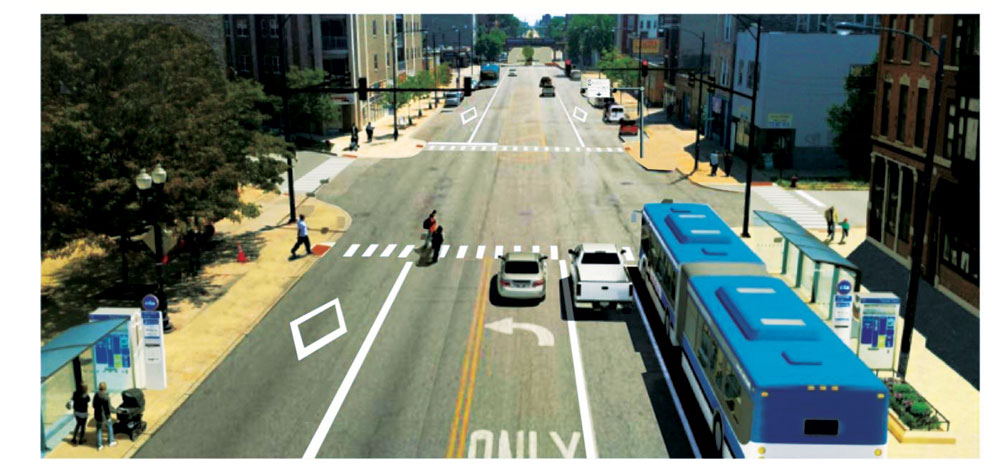

RTD’s Colfax buses are nearing capacity and a new Denver study is concluding that bus rapid transit is the best solution. The Colfax Corridor Connections study covers the 10-mile-long Colfax corridor from I-25 (Auraria campus) to I-225 (Anschutz medical campus). The 15 and 15L bus lines are the region’s busiest, carrying 22,000 riders each day. With no action, bus capacity tops out at 26,000 trips in 2035. With bus rapid transit (BRT), transit capacity grows to 50,000 trips/day.
Project Manager Ryan Billings (Denver Public Works Dept.) told a crowd gathered at the Knights of Columbus building in January that Denver has attracted 100,000 new residents since 2008. Growth projections for the Colfax corridor are even more impressive: a 25 percent growth in population and a 67 percent growth in employment by the year 2035. The city has concluded that taking no action is not acceptable. The goal of the $2 million Denver study is to “mitigate but not solve congestion,” Billings said.
![]()
By the year 2035, the Colfax corridor is projected to grow 25 percent in population and 67 percent in employment.
![]()
The BRT solution would increase the total of auto-person and transit-person trips from its current 61,000 per day to 83,000 by 2035. Transit capacity would more than double to 50,000 trips per day while auto-person trips would drop from the existing 39,000 to 33,000.
And therein lies the rub: this loss in auto-person trips/day comes about because the BRT would operate in exclusive lanes for the 4.7 mile stretch of the corridor from Broadway to Syracuse St. There, private vehicles would be removed from two of Colfax’s four lanes during peak hours (the morning and afternoon/evening rush hours).
Denver is moving ahead with this “locally preferred alternative” despite complaints from some bordering neighborhoods that the reduced auto capacity on Colfax will force drivers to side streets such as the 13th/14th Avenue one-way couplet. Denver staff counter that the no-action alternative will have a similar effect without increasing the corridor’s capacity to move people by whatever means.
Project staff also cite the reduction in end-to-end travel time of 10 minutes as another reason to support BRT.
BRT was selected from a laundry list of technologies that ranged from enhanced bus service to gondolas, mag-lev trains and light rail. Key features of BRT include high frequency (5-minute headways) and rapid boarding through means such as low floor boarding, multiple bus doors and off-vehicle ticketing.
By comparison to its closest competing technology, the modern streetcar, BRT was found to be much lower in capital and operating costs leading to a better “cost-effectiveness” rating that will be crucial when Denver seeks federal financial assistance for the project. Total capital cost is projected to be $125–$135 million in today’s dollars.
Another factor favoring BRT is the conclusion that it would have minimal environmental impacts, meaning Denver can wrap up the study this spring and issue what is referred to in the industry as a “categorical exclusion,” a relatively expedited and lower-cost environmental study. That would put the city in a position to begin the pursuit of federal dollars sooner than if it had to undergo a full environmental impact statement. This “cat-x” option is possible mainly because the BRT technology will not require any private property acquisition. Denver identified 2021 as the rough target for project implementation.
In the meantime, Denver is planning $11 million in selected bus stop improvements along the corridor as part of a separate project funded by a package of federal, state and regional grants matched by local (Denver) funds. The design phase has begun and improvements would be constructed beginning by year’s end. Improvements will include increased security and safety (cameras and lighting), curb extensions where feasible, new shelters, as well as Transit Signal Priority and queue bypass lanes where feasible.
Colfax Corridor Connections is a $2-million study, funded jointly by Denver and the Federal Transit Administration. RTD is a major project stakeholder and, as the transit operator, will need to endorse the locally preferred alternative if it is to proceed beyond the design phase.




0 Comments